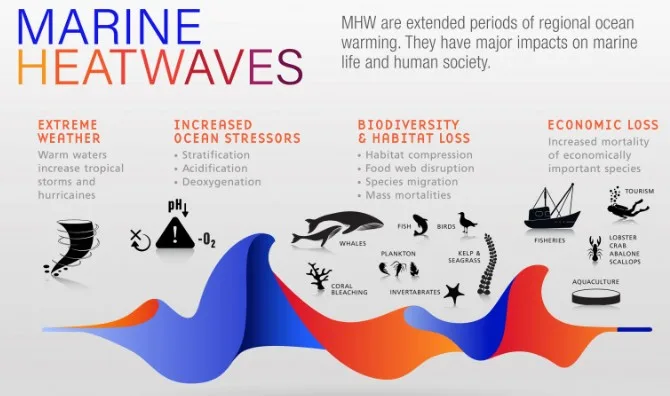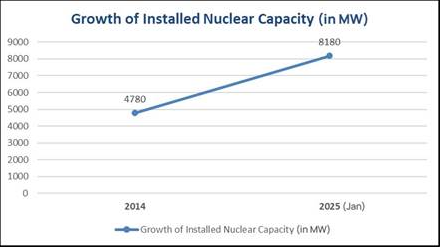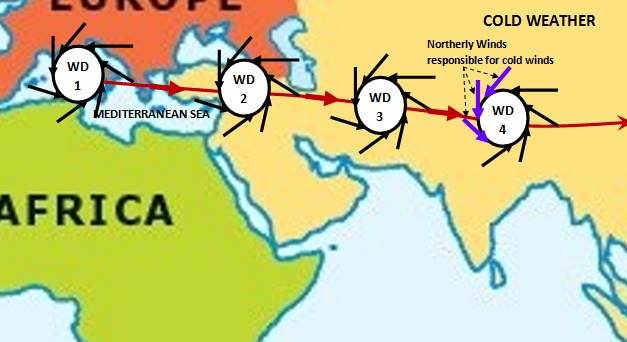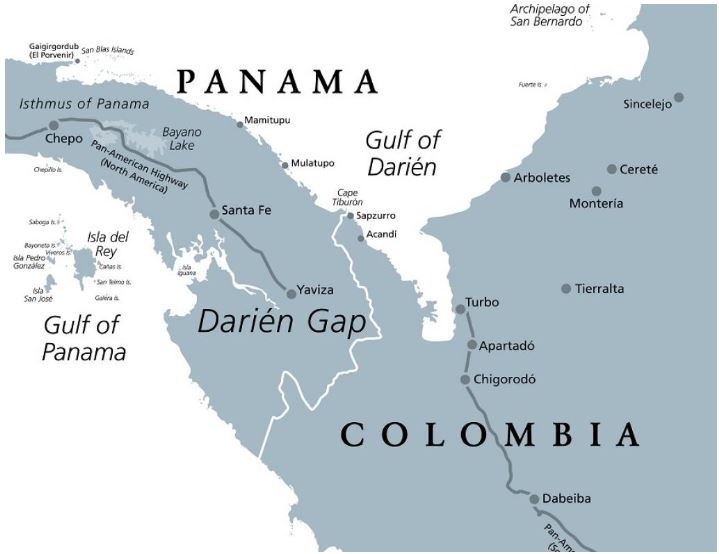Climate Crisis has Intensified Marine Heatwaves Across the World
Syllabus :GS3/Environment
In News
- In January 2025, marine heatwaves (MHWs) in Western Australia led to the death of over 30,000 fish.
What are Marine Heatwaves?
- They are periods of extremely high temperatures in the ocean.
- They occur when sea surface temperatures rise 3-4°C above average for at least five days.
- They can last from weeks to years.
- Climate change is the primary cause, with 90% of excess heat absorbed by oceans.
- They have become more frequent, intense, and longer-lasting in recent decades.
Global Presence
- They are observed in several oceanic regions: North Pacific, North Atlantic, Mediterranean, Caribbean Sea, and parts of the Indian Ocean.
- They can cause extreme weather events, like tropical storms and hurricanes, and disrupt the water cycle, increasing floods, droughts, and wildfires.
Recent Trends in the Indian Ocean
- MHWs, once rare in the tropical Indian Ocean, have become annual events.
- Western Indian Ocean and Bay of Bengal experienced a significant rise in MHWs, with 1.5 events per decade in the western Indian Ocean and 0.5 events per decade in the Bay of Bengal between 1982-2018.
Impacts
- Monsoons: MHWs in the western Indian Ocean and Bay of Bengal influence monsoon patterns, causing drying in central India and increased rainfall in southern India.
- These changes are linked to altered atmospheric circulation driven by the heatwaves.
- Socio-economic: MHWs negatively affect coastal communities, aquaculture, fisheries, and tourism.
- They can reduce productivity of important species like lobster, snow crab, and scallops.
- Disruption of ecosystems can harm the fishing industry and related livelihoods.

- Biodiversity and Ecosystem Destruction: MHWs can cause mass mortality of marine species, forcing them to relocate or change behavior.
- Ecosystems, such as kelp forests and coral reefs, are especially sensitive to MHWs.
- MHWs contribute to coral bleaching, reducing coral reproductive ability and making them more vulnerable to disease.
- Other threats, like ocean acidification and overfishing, compound the damage caused by MHWs.
- Ecosystems, such as kelp forests and coral reefs, are especially sensitive to MHWs.
Strategies to Combat MHWs
- Slow down ocean warming by reducing fossil fuel emissions (aligning with Paris Agreement goals).
- Invest in nature-based solutions and apply the IUCN Global Standard for Nature-based Solutions.
- Build research capacity to monitor MHWs, understand their impacts, and predict future events.
- Develop global research networks (e.g., Marine Heatwave International Group).
Way Ahead
- Governments should implement protective measures, such as marine protected areas, to safeguard vulnerable species.
- Enforce fishing regulations and catch management to limit economic losses.
- Raise awareness among stakeholders, including policymakers, researchers, and the private sector.
Role of Governor Over Assenting Bills
Syllabus: GS2/Polity and Governance
Context
- Recently, the Supreme Court questioned the Tamil Nadu Governor over his decision to keep several Bills pending for over three years.
About
- The Governor, as the constitutional head of a state, plays a crucial role in the legislative process, particularly in assenting to bills passed by the state legislature.
- The discretion exercised by Governors in withholding or delaying assent has been a subject of legal scrutiny and political contention.
Constitutional Provisions
- Article 200 of the Indian Constitution: It outlines the Governor’s role in the assent process.
- When a bill is presented to the Governor after being passed by the State Legislature, they have four options:
- Grant Assent – The Governor may approve the bill, making it a law.
- Withhold Assent – The Governor may reject the bill, effectively stopping it from becoming law.
- Return the Bill for Reconsideration – The Governor can send the bill back to the legislature with suggestions. However, if the legislature passes the bill again without modifications, the Governor is bound to give assent.
- Reserve the Bill for Presidential Assent – If the bill is contrary to the Constitution, affects the powers of the High Court, or contradicts central laws, the Governor may reserve it for the President’s decision.
- When a bill is presented to the Governor after being passed by the State Legislature, they have four options:
- Article 201: President’s Role in Reserved Bills
- If a bill is reserved for the President’s consideration under Article 200, the President has two options:
- Give Assent: The bill becomes law.
- Withhold Assent or Direct Reconsideration: The President may send the bill back to the State Legislature for reconsideration. If the Legislature re-passes the bill, the President is not bound to give assent.
- If a bill is reserved for the President’s consideration under Article 200, the President has two options:
Controversies and Recent Developments
- Delays in Assent: While the Constitution does not specify a timeframe for the Governor to act on a bill, it mandates that actions should be taken ‘as soon as possible’.
- Indefinite delays can lead to a constitutional impasse, undermining the democratic process.
- Instances of prolonged delays and the use of the ‘pocket veto’ (withholding assent without returning the bill) have raised concerns about the Governor’s impartiality and adherence to constitutional norms.
- Political Disputes: Some state governments have accused Governors of acting under the influence of the central government, undermining the principles of federalism.
- In states like West Bengal, Maharashtra, and Punjab, conflicts have arisen over the Governor’s refusal to sign bills crucial for governance.
Supreme Court Observations/Interpretations
- Shamsher Singh v. State of Punjab (1974): Governor is bound to act on the aid and advice of the Council of Ministers except in certain specified cases.
- Nabam Rebia v. Deputy Speaker (2016): Governor cannot act in a partisan manner or override the elected government’s decisions without valid reasons.
- Rameshwar Prasad Case (2006): Governor’s discretion should not be arbitrary and must align with constitutional principles.
Discretionary Powers
- The Governor’s discretion in withholding assent or returning a bill is not absolute.
- The Sarkaria Commission (1987) further emphasized that the reservation of bills for the President’s consideration should be an exception and not the norm.
- It recommended that the President should decide on such bills within six months and communicate reasons if assent is withheld.
Reforms and the Way Forward
- Time-bound decision-making: The Supreme Court has hinted that Governors should not indefinitely delay assent.
- The Governor should communicate promptly with the state legislature, providing reasons for withholding assent or referring bills to the President.
- Clarification on discretionary powers: A clearer constitutional or judicial framework is needed to define the limits of the Governor’s role.
- Establishing clear guidelines for the Governor’s actions in assenting bills can help ensure transparency and accountability.
- Greater accountability: The Governor’s actions should be subject to parliamentary or judicial review if they appear to be politically motivated.
- Strengthening judicial oversight can help prevent misuse of the Governor’s powers and ensure adherence to constitutional principles.
States Demand for Increase Share in Central Taxes
Syllabus: GS3/ Economy
Context
- Odisha has joined the growing demand for the Finance Commission to raise States’ share in India’s divisible tax pool to 50%, from about 41% currently.
What is Tax devolution?
- Tax devolution refers to the distribution of tax revenues between the central government and the state governments.
- The central government collects taxes (like income tax, GST, etc.) and a portion is shared with the states based on the Finance Commission’s recommendations.
- Objective: To promote fiscal federalism, strengthen the financial autonomy of state governments, and empower them to meet the needs of their respective populations.
- Formula Used: States’ share is decided by a formula meant to incentivize demographic performance and each state’s effort to mobilize its own tax revenue.
- The formula also takes into account geographic area, forest cover and the state’s per capita income.
- The Centre also aids States through additional grants for certain schemes that are jointly funded by the Centre and the States.
| Constitutional Provisions Related to Centre State Financial Relations – Articles 202 to 206 deal with the financial administration of states, including provisions related to their budget, expenditure, borrowing, and taxation powers. – Articles 268 to 272 outline the distribution of revenues between the Union and the states. – Article 280 provides for the establishment of a Finance Commission every five years (or as specified by the President). – Article 282 allows the Union government to provide financial assistance to states for any public purpose. |
Current Share of the States
- Recommendations of the 14th FC: It hiked the tax devolution to states to 42% from 32%, and also added a new provision of revenue deficit grants to states facing any resource gap.
- The 15th finance commission, under the chairmanship of N K Singh has revised tax devolution and brought it down to 41% from 42%.
- So the current tax devolution to states stands at 41% till 2026.
- The 90:10 rule is still applicable to the northeastern and hill states, although there is no special status category.
- All the other states receive Central funding in a 60:40 ratio, 60% being the Central government’s contribution and 40% states.
Concerns of the States
- Demand for more funds: States argue they should receive more funds than recommended by the Finance Commission.
- States argue that they have greater responsibilities, including education, healthcare, and policing services.
- Disparities Among States: Developed States like Karnataka and Tamil Nadu feel they receive less money from the Centre than they contribute in taxes.
- It is argued that more developed States with better governance are being penalized by the Centre to help States with poor governance.
- Divisible Pool Concerns: Cesses and surcharges, which are not shared with the States, can constitute up to 28% of the Centre’s tax revenues, leading to revenue losses for States.
Way Ahead
- The 16th Finance Commission should review the States’ demand for a higher tax devolution based on fiscal needs and expenditure responsibilities.
- Strengthening Disaster Resilience Funding: A separate central disaster relief fund could be established for disaster-prone States to ease their financial burden.
- Capacity Building: Strengthening the financial management and capacity of states to better utilize devolved funds for development.
Private Sector Involvement in India’s Nuclear Sector
Syllabus: GS3/ Economy
Context
- The Union government is considering allowing private sector participation to achieve 100 GW of nuclear power capacity by 2047.
About
- Traditionally, nuclear power plants in India have been owned and operated only by state-owned Nuclear Power Corporation of India Ltd (NPCIL) and its fully-owned subsidiary Bharatiya Nabhikiya Vidyut Nigam (BHAVINI).
- To allow private sector participation government has proposed amendments to key legislations;
- Atomic Energy Act, 1962, a framework for nuclear energy development and regulation.
- Civil Liability for Nuclear Damage Act, 2010, ensuring compensation mechanisms for nuclear incidents.
- The government will enter into partnerships with the private sector with the motive of;
- Setting up Bharat Small Reactors,
- Research & development of Bharat Small Modular Reactor, and
- Research & development of newer technologies for nuclear energy.
| What is Nuclear Energy? – Nuclear energy is the energy released during nuclear reactions, either through fission (splitting of atomic nuclei) or fusion (merging of atomic nuclei). – In nuclear fission, heavy atomic nuclei, such as those of uranium or plutonium, are split into lighter nuclei, releasing a large amount of energy. 1. This process is utilized in nuclear power plants to generate electricity. |
Status of Nuclear power capacity in India
- The current installed nuclear power capacity in the country is 8,180 MW, spread across 24 nuclear power reactors.
- Capacity Expansion: 10 new reactors (totaling 8 GW) under construction across Gujarat, Rajasthan, Tamil Nadu, Haryana, Karnataka, and Madhya Pradesh.
- Approval for a 6×1208 MW nuclear plant in Andhra Pradesh in collaboration with the USA.

Benefits of Private Sector Involvement
- Faster Capacity Expansion: Private investment will help bridge the financial gap needed for rapid nuclear power growth.
- Technological Advancement: Collaboration with private companies drive innovation and bring in global expertise.
- Cost Efficiency: Competitive bidding and private participation will help reduce project costs and delays.
- Energy Security: Increased nuclear power generation helps India reduce dependence on fossil fuels and meet clean energy goals.
Concerns to Private Sector Entry
- Regulatory Hurdles: Amendments to existing laws are required to enable private sector participation.
- High Capital Requirement: Nuclear power projects involve long gestation periods and large upfront investments, which deters private players.
- Liability Concerns: The Civil Liability for Nuclear Damage Act imposes high liability on operators, making private investment risky.
- Safety and Security: Nuclear energy requires strict safety protocols, and allowing private firms to operate reactors necessitates robust regulatory oversight.
- Public Perception: Concerns over nuclear safety, waste management, and radiation risks will face public resistance.
Government steps
- India had announced a Rs 20,000 crore R&D mission for development of small modular reactors (SMRs).
- India is also targeting the deployment of at least five of these indigenously developed reactors by 2033.
- NPCIL and National Thermal Power Corporation (NTPC) have signed a supplementary Joint Venture agreement to develop nuclear power facilities in the country.
Way Ahead
- Clear Regulatory Framework: Establish a robust regulatory environment to ensure safety, compliance, and transparency, addressing concerns about accountability and national security.
- Public-Private Partnerships (PPPs): Promote partnerships where the government maintains oversight, while private players handle operations, innovation, and investment, ensuring a balance of interests.
- Gradual Implementation: Start with pilot projects and small-scale initiatives to test private sector involvement, ensuring risk management before large-scale implementation
India’s Diagnostics Sector
Syllabus: GS3/ S&T
Context
- India’s diagnostics sector plays a crucial role in the healthcare industry, facilitating early disease detection and treatment planning.
- The tragic case of Shankar Dhange, whose sister lost her life due to incorrect diagnostic test results, underscores the serious risks posed by inadequate regulation and oversight.
India’s Diagnostics Sector: Growth and Importance
- The diagnostics sector contributes 9% of the total healthcare industry and plays a crucial role in disease management and medical decision-making.
- The Indian diagnostics industry is expanding at a rapid pace, with an estimated value of ₹1,275 billion by 2028.
- There are approximately 300,000 labs across India, serving a growing population.
- The early disease detection with the rise of digital health platforms and AI-driven diagnostics is shaping the future of medical testing in India.
Challenges Facing the Diagnostics Sector
- Weak Regulatory Oversight: Only 12 states and Union Territories have adopted the Clinical Establishments Act, leading to inconsistent regulations across the country.
- No mandatory accreditation for labs, allowing many to operate without standardized quality control.
- Shortage of Skilled Personnel: Lack of trained pathologists, microbiologists, and lab technicians affects diagnostic accuracy.
- Urban-Rural Divide: Only 24% of diagnostics revenue comes from rural areas, despite 70% of India’s population residing there.
- Government-run labs lack proper infrastructure, funding, and trained staff.
- High Cost of Private Diagnostics: No standardized pricing for tests, leading to disparities in cost.
- Private labs often charge exorbitant fees, making diagnostic services inaccessible to low-income groups.
- Initiatives like Telangana’s ‘T-Diagnostics’ and Kerala’s ‘Aardram Mission’ aim to provide affordable diagnostics but face logistical challenges.
- Fraudulent Practices: Fake pathologists and unauthorized technicians are common, compromising patient safety.
- Some labs use “bought signatures” of pathologists to issue reports without proper review.
Regulations of the Sector
- Clinical Establishments (Registration and Regulation) Act, 2010: Aims to regulate diagnostic centers and set minimum standards for services.
- Adopted by only 12 states and Union Territories, with poor implementation.
- NABL Accreditation: The National Accreditation Board for Testing and Calibration Laboratories (NABL) provides voluntary accreditation.
- Large diagnostic chains follow NABL guidelines, but many small labs operate without accreditation.
- State-Specific Regulations:Karnataka and Kerala have separate regulatory frameworks, but enforcement remains inconsistent.
- Tamil Nadu’s new Clinical Establishments (Regulations) Rules, 2018, mandate minimum space requirements for labs.
Way Ahead: Reforming India’s Diagnostics Sector
- Strengthening Regulations and Compliance:Make NABL accreditation mandatory for all diagnostic centers.
- Ensure uniform implementation of the Clinical Establishments Act across all states.
- Establish a central regulatory body for consistent oversight.
- Expanding Workforce and Training Programs: Increase medical education seats and training programs for microbiologists, pathologists, and lab technicians.
- Mandate regular upskilling and certification for lab technicians.
- Set a cap on the number of labs a pathologist can be associated with to curb ghost pathologists.
- Eliminating Fraudulent Practices: Implement digital tracking of lab reports to prevent misuse of pathologists’ credentials.
- Enforce strict penalties for ghost pathologists and unqualified technicians.
- Conduct regular audits and surprise inspections to ensure compliance.
- Bridging the Urban-Rural Divide: Increase government investment in rural diagnostic centers.
- Expand public-private partnerships (PPPs) to improve access to diagnostics in remote areas.
- Extend successful state-funded diagnostic initiatives like ‘T-Diagnostics’ and ‘Aardram Mission’ to other regions.
- Standardizing Pricing and Quality Control: Introduce price caps for essential diagnostic tests.
- Mandate Standard Operating Procedures (SOPs) for sample collection, testing, and reporting.
- Enforce external and internal quality control measures.
Western Disturbance
Syllabus: GS1/ Geography
In Context
- The India Meteorological Department (IMD) has reported a sharp temperature drop across North India due to an active western disturbance positioned over North Pakistan.
What is Western Disturbance (WD)?
- It is an extra-tropical storm that originates in the Mediterranean region.
- The disturbance travels from the “western” to the eastern direction and gradually travels across the middle-east from Iran, Afghanistan and Pakistan to enter the Indian subcontinent.
- Disturbance means an area of “disturbed” or reduced air pressure.
- Equilibrium exists in nature due to which the air in a region tries to normalize its pressure.
- Disturbance means an area of “disturbed” or reduced air pressure.
- In the term “extra-tropical storm”, the storm refers to low pressure.
- “Extra-tropical” means outside the tropics (as WD originates outside the tropical region).
- The disturbance travels from the “western” to the eastern direction and gradually travels across the middle-east from Iran, Afghanistan and Pakistan to enter the Indian subcontinent.

Impacts
- It brings rainfall, snowfall, and fog to northern India.
- WD is important for the agriculture of the Rabi crop in the Northern subcontinent.
- The WD is not always the harbinger of good weather and sometimes, they can cause extreme weather events like floods, flash floods, landslides, dust storms, hail storms and cold waves killing people, destroying infrastructure and impacting livelihoods.
| Indian Meteorological Department – Established in 1875. – The India Meteorological Department is an agency of the Ministry of Earth Sciences of the Government of India. – It is the principal agency responsible for meteorological observations, weather forecasting and seismology. |
Source: PIB
Darien Gap
Syllabus: GS1/World Geography
Context
- Darien Gap was in the news for being a major route for the illegal migration to the US.
Darien Gap
- The Darien Gap is a dense, swampy rainforest spanning approximately 97 km (60 miles) between northern Colombia in South America and southern Panama in North America.
- Environment: The terrain is characterized by muddy trails, wetlands, and steep mountains, making it one of the most inhospitable and dangerous regions in the world.
- Concerns: The area is controlled by criminal gangs and armed groups, further increasing the dangers for those attempting to cross it.

Source: IE
Power to Grant Furloughs
Syllabus :GS 2/Governance
In News
Convicts of the Hashimpura massacre have moved the Delhi High Court against a Delhi prison rule about furloughs.
- The rule vests power to grant furlough with the court where the appeal against conviction is pending.
About Furloughs and How is it different from Parole?
- Both furlough and parole are conditional releases, but differ in their implications.
- Furlough allows convicts to be temporarily released without suspending their sentence, meaning the time spent on furlough counts toward the sentence.
- It is typically granted to long-term prisoners for reasons like preventing isolation and fostering social ties.
- Parole suspends a convict’s sentence temporarily and is usually granted for specific reasons like illness or agricultural needs.
- Delhi Prison Rules 2018: The challenged rule (Note 2 of Rule 1224) states that furlough cannot be granted if an appeal is pending before the High Court or Supreme Court, and the convict must seek the court’s direction.
- This provision is under scrutiny as it may violate constitutional rights, including Articles 14 (equality) and 21 (right to life and liberty), and may contradict the reformative approach to punishment.
- High Court’s Interpretation: A single judge of the Delhi HC has interpreted that the rule applies to both the Delhi HC and SC.
- Now, a division bench is examining the rule’s constitutional validity and whether it unfairly denies furlough despite good behavior.
| Do you know? – The case of KM Nanavati in 1960 set a precedent where the SC ruled that only the court, not the governor, can suspend a sentence during the pendency of an appeal. – Some states deny furlough during an appeal, with NALSA highlighting that this is because convicts can request relief from the court. 1. Several states are part of ongoing litigation regarding this practice. |
Source :IE
Brucellosis
Syllabus: GS 2/Health
In News
- An eight-year-old girl from Kerala recently died after being treated for brucellosis for two months.
About Brucellosis
- It is a bacterial zoonotic disease caused by Brucella species, mainly affecting livestock like cattle, goats, sheep, and swine
- Transmission : It is transmitted to humans through contact with infected animals, consumption of unpasteurized milk or cheese, or inhalation of airborne agents.
- The disease is common in endemic areas and can have serious public health implications.
- Most cases result from consuming raw milk or cheese, especially from sheep and goats.
- Symptoms of brucellosis include fever, weakness, weight loss, and general discomfort.
- In many cases, symptoms are mild, which can delay diagnosis. The incubation period varies from one week to two months, but usually lasts 2-4 weeks.
- Risk Groups: Farmers, butchers, veterinarians, and laboratory workers are at higher risk due to direct contact with infected animals, blood, or bodily fluids.
- Prevention and Control: The key strategy is to eliminate infection in animals, including vaccination and culling.
- Pasteurization of milk and raising awareness about food safety help reduce human infection.
- Brucellosis is treated with doxycycline combined with streptomycin or rifampicin, typically for 45 days.
Source :TH
Chandrayaan-4 Set to Launch in 2027
Syllabus: GS3/ Science and Technology
Context
- India will launch the Chandrayaan-4 mission to bring back samples of moon rocks to the Earth in 2027.
About
- Chandrayaan-1: It was launched in 2008 and was India’s first lunar mission. It made India the fifth country to reach the Moon.
- The mission’s most significant discovery was the presence of water molecules on the lunar surface, a finding confirmed by NASA.
- Chandrayaan-2: It was launched in 2019 with an orbiter, a lander (Vikram), and a rover (Pragyan).
- The mission aimed to achieve a soft landing on the lunar surface, but ISRO lost contact with the lander just before touchdown, resulting in a crash landing.
- Despite this setback, the orbiter continued functioning and provided crucial data on the Moon’s surface and atmosphere.
- Chandrayaan-3, a follow-on mission to Chandrayaan-2, successfully achieved a soft landing on the Moon’s south pole in 2023.
- Lander payloads: Chandra’s Surface Thermophysical Experiment (ChaSTE) to measure the thermal conductivity and temperature; Instrument for Lunar Seismic Activity (ILSA) for measuring the seismicity around the landing site etc.
- Rover payloads: Alpha Particle X-ray Spectrometer (APXS) and Laser Induced Breakdown Spectroscope (LIBS) for deriving the elemental composition in the vicinity of landing site.